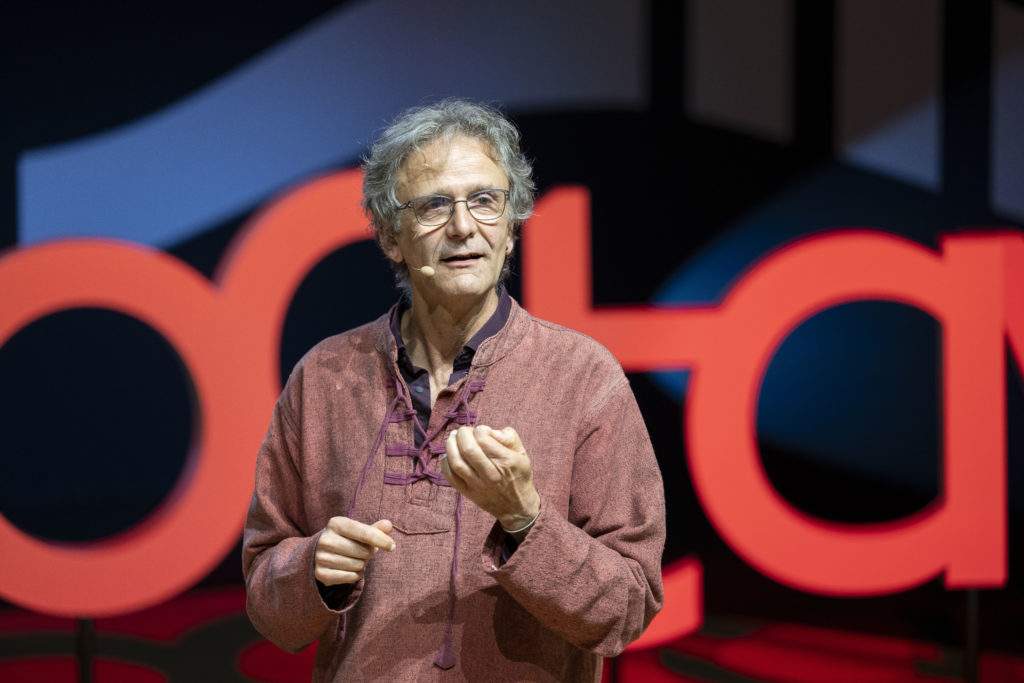What do words say about age? A brief foray into “intergenerational” vocabulary
What do words say about age? A brief foray into “intergenerational” vocabulary
.
Juniors, seniors, boomers, GenX, GenY, millennials, silvers, youthism, ageism, middle-age: there is now an entire newspeak of “intergenerational” terms. Lots of them are neologisms, some are code names… And could many be euphemisms? If so, what do they hide? What do these terms suggest about the various times in all our lives? The webmagazine team takes a closer look.
Once upon a time, the idea of youth just didn’t exist
We were all adults in the making… or adults approaching the end of our life on earth
Let’s start by taking a look back through history. After digging around a little, it becomes clear that the idea of ‘young people’ is a very recent phenomenon. The historian Philippe Ariès was the first to suggest that the ‘ages of life’ are actually a fairly recent construct. And it all starts with the ‘discovery’ that childhood is not simply an introduction to real life as an adult human being. It was only at the very end of the 18th century that ‘being a child’ became recognized as a stage of life. From that point on, childhood was considered to be a specific period in its own right, and began gaining value (especially legally, because laws were brought in at that time to prohibit work below a certain age). Children were no longer considered to be ‘mini adults’, but children, with children’s lives and a relationship with the ‘other’ age group: adults. Because yes, at that time there were only differences between children and adults, with a slight nuance for the treatment reserved for ‘old people’, who were regarded as patriarchs.
The birth of adolescence
The idea of there being a period of adolescence took hold as the field of psychology developed, designating the time when a young person has gone through puberty but is not yet an adult. This stage of life had received legal attention due to the condition of girls: from the Middle Ages it was deemed necessary to establish a form of ‘social contraception’ in the words of the historian Patrice Huerre whose field of interest is the standards regulating the age of marriage. Even though girls were physically able to have children, that didn’t mean that they were able to live as adults!
The law provided protection but set constraints for older teenagers who became more and more impatient during the years leading up to their legal adulthood, which was 25 years until 1792 and 21 years until 1975.
And then in 1968, the youth movement finally happened!
There were rumblings at the end of the 1960s among the boys and girls who were born during the baby boom and grew up during the wonderful Trente Glorieuses between 1945 and 1979. They were determined to talk during family meals without asking their father’s permission, at university without deferring excessively to their professors, in politics where they wanted to be taken seriously, and at work where they refused to be admonished!
‘Young people’ sought to be recognized as adults, but didn’t want the lifestyles of their ‘old’ parents. They weren’t interested in bringing their adolescence to an end, nor did they want to rush off and start a family and build a house. They weren’t looking to overwhelm themselves with responsibilities either, they demonstrated a furious desire to ‘live their youth to the full’. And that’s how the boomers invented the concept of youth in around 1968 as a period of life during which people should enjoy their independence and their right to be carefree. A time for partying and debate. The idea of ‘try before you buy’ applied everywhere, including jobs and partners, and it was suddenly possible to change your mind or your career before perhaps settling down later.
The invention of seniors… Juniors and silvers
When ageing is in bad taste
As soon as youth became a concept, the idea of getting older was no longer appealing! First and foremost for the generation that invented youth as a counterpoint to grim old age: the ‘boomers’. In the world today, these pioneers aren’t going to have their brilliant idea of youth taken away from them by kids of just 20 (or 30, or 40) years old who swarm in and push them to move aside or retire. You must be kidding! They have decided that they’re not old people, they’re… Seniors! But not in the Latin sense of the word, which designates an old or even dying man. No, these are seniors just like in college, like athletes who are over 20 years old before they choose to become ‘veterans’. ‘Seniority’ doesn’t necessarily mean you’re old, it just means you’re experienced, even if you’re given the title ‘Senior Manager’ after just four years with a company!
A ‘senior’ in this context is therefore different from an ‘old person’. Senior people are mature, but have not necessarily lost their freshness, they haven’t left their youth behind. It’s a tempting idea. For young people who can manage to shake off their age and achieve recognition for their experience and for not-so-young people who can keep a fresh attitude to work while retaining what they have learnt over their years of experience and the comfort it has afforded them.
Juniors, with potential to become seniors; silvers, who challenge the concept of age
So nobody wants to be either ‘too’ young (wet behind the ears) or ‘too’ old (a has-been). But there is always a way to flatter everyone: a junior is an intermediary between the newbie and the senior. The name suggests potential, the promise of beautiful and lasting seniority in the making, future opportunities to prove oneself.
At the other end of the spectrum, the not-so-young are certainly not going to lie down and be trampled on! They are retired (or about to be), but fit and healthy. They are involved in all kinds of projects, and while they enjoy sharing what they have learnt, they don’t see themselves as patient wise men and women who watch the world transforming without taking part in it. These people make up the ‘silver economy’. Their beautiful gray hair flows around their faces and they are the coolest grandparents. They only talk about the effects of aging in terms of crow’s feet wrinkle smiles (beauty creams), cycling (urinary problems), sailing (hearing aids) or barbecues (because they need reminding that social distancing and other preventive measures are essential in the fight against CoVid-19), etc.
Intergenerational: no more ‘young’ or ‘old’, just different generations?
Working together…
Intergenerational issues are all the ideas about age and the social conditions that go hand-in-hand with each stage of life. The word ‘intergenerational’ appeared in sociological literature as early as the 1970s, mainly to address the question of renewing relationship patterns between children, parents and grandparents during major changes in family unit structures.
As we have already said, children now have a voice, young people go on living willingly with their parents as adults, at least until they finish studying, or even for a few years in their first real job. Parents don’t force themselves to live as a couple their entire lives, and allow themselves a ‘second chance at youth’ when their children have grown up. They sometimes marry again – or not – and form new couples, which is hardly compatible with having grandpa and grandma under the same roof. Moreover, now as grandparents, baby boomers are keen to look after their grandchildren from time to time but are less and less willing to provide constant daycare; they too want their independence, they want to pursue their own interests and make plans, they want to live their lives. And because everyone knows what they want, it should be easy…
… Then the conflicts begin
The issue is that each age group is influenced by how its members were raised. The older generations of today no longer sit in armchairs by the fireside, but they find it difficult to relinquish the stern authoritarianism in which they were raised. Young adults, because they were not involved with money matters during their childhood, want autonomy but they don’t want to have to worry about putting food on the table. ‘New’ parents aspire to less vertical, more democratic relationships with their children, but when they arrive, the parents feel they should be in charge! Similarly, while there are internal, individual tensions for each age group, there is also friction between the different age groups. Intergenerational concerns arise when we need to think about that friction and the dynamics which sometimes suggest that the different generations are fighting each other.
Effect of age/generation
‘I hope I die before I get old’ said The Who in their hit Talking About my Generation in 1965 But there’s a difference between a generation and an age of life.
- The age effect, points out Louis Chauvel in Le destin des générations, covers everything that corresponds to a certain age in life, regardless of the generation to which one belongs. For example, it is an ‘age effect’ to start your first job between the ages of 18 and 25 or to have your first child between 20 and 30, and that applies whether you were born in 1930, in 1950 or in 1970.
- The generation effect is the fact that someone born in the same historical period as you has the same experience, common references, ways of reading the world and typical situations. A classic example would be a British person born in the 1970s who remembers eating Nerds and drinking Lilt while listening to Kylie Minogue singing I Should Be So Lucky on a battery-powered walkman, while a person born in the 2000s has never listened to music using a physical medium and only rarely will listen to an entire album. Each generation has its own references!
Why are there so many Ys? It’s rather X-cessive!
The notion of intergenerationalism and theoretical thinking about the issue first took hold in the business world during the 2000s, when Gen Y (why?) arrived on the labor market asking constant questions and couldn’t get down to business before receiving answers. Gen Y is on the other end of the spectrum from the Boomers, with Gen X in the middle like the missing pieces of an unknown puzzle.
The clues to resolving this unknown puzzle seem to lie in figures: how much does it cost to turn down a ‘new generation’ talent for a job? What is the price of Gen X-style management? How much are Boomers going to drain away when they retire, especially because Gen Z are studying endlessly and doing endless internships before getting their feet on the salary ladder.
Are we denying the effects of age?
Youthism or the untenable promise of never getting old
Senior, junior, boomer, X, Y, Z the list goes on. When newspeak appears, it’s often because there is something embarrassing that needs to be hidden behind new, fresh and beautiful words.
So what is it in this case? To begin with it’s the persistent youthism which dominates our thinking, and it does so effectively because we don’t really call it by its name. In contrast to what you might think, ‘youthism’ does not mean discrimination against young people, but actually refers to all the sociocultural signals that give young people an advantage over older people. In society generally, ‘youthism’ encompasses everything to do with the attribution of desirable qualities to youth: freshness, dynamism, beauty, sense of trends, agility and so on. And it’s reflected in various ways: a preference for young people in certain trades or sectors; representations in advertising imagery or anything else that needs to be made attractive by figures of youth (you’ve seen it before, a mother in a sit-com who is supposed to be in her forties, but is played by a 25 year-old actress!). Youthism means valuing people who ‘don’t look their age’, with the powerful moral implication that this fresh ‘well-preserved’ appearance can be attributed to a healthy lifestyle, good self-esteem, it is even a form of respect! Youthism means encouraging people to slow down their lives lest the passing of time leave its marks on their bodies and minds.
Ageism or the observation that growing old is bad
But then is there a word for the stereotypes used to describe a specific age group and its associated discriminations? There is one, yes, but using it actually underscores the problem of youthism: the word is ‘ageism’ and we use it almost exclusively to talk about discrimination linked to being… old! That was its original meaning when it was coined by the gerontologist Robert Butler in 1969. Mr Butler gave it the following definition: “profound psychosocial disorder characterized by institutionalized prejudices, stereotypes and the installation of a distance or avoidance of elderly people”. This is well understood and clear to see in employment figures for active workers over 49 years old (14% of whom are unemployed in the 49-55 age group; 28% between 56 and 60 years and 69% between 61 years and retirement).
What about young people?
So does that mean young people aren’t discriminated against, because there isn’t a word for it? Of course not! They too are subjected to stereotypes, both positive and negative, which affect their socioeconomic position: nearly 20% of active 15-24 year olds are unemployed, and the same proportion of 19-29 year olds are in situations of financial instability (not to say poverty). And youth is an ‘aggravating factor’ for other forms of discrimination: young women, young people of color, and young people with disabilities see their chances of entering the labor market drastically reduced, let alone reaching a position of responsibility. It’s easy to say that something you can’t measure with statistics does not exist. But it is clear that when something doesn’t have a specific name, or has a challenging name, it is resistant to change, even when the numbers back up the ideas.
Marie Donzel. Translated from French by Ruth Simpson.
Share this Post








